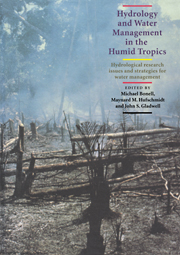 Hydrology and Water Management in the Humid Tropics
Hydrology and Water Management in the Humid Tropics Book contents
- Frontmatter
- Contents
- List of Authors
- Foreword by Federico Mayor, Director-General, UNESCO
- Preface
- Cartographic Credit
- Acknowledgements
- SECTION I INTRODUCTION
- SECTION II HUMID TROPICS SETTING
- SECTION III REGIONAL HYDROLOGY
- SECTION IV PHYSICAL PROCESSES
- SECTION V PHYSICAL PROCESSES – HUMAN USES: THE INTERFACE
- SECTION VI MANAGEMENT ISSUES
- 22 Water Resource Management
- 23 Water Management Issues: Population, Agriculture and Forests – A Focus on Watershed Management
- 24 Urban Water Resources in the Humid Tropics: An Overview of the ASEAN Region
- 25 Urban Water Problems in the Humid Tropics
- 26 Rethinking Urban Water Supply and Sanitation Strategy in Developing Countries in the Humid Tropics: Lessons from the International Water Decade
- 27 Water Resource Management Issues in the Humid Tropics
- SECTION VII APPENDICES
- Place index
22 - Water Resource Management
Published online by Cambridge University Press: 23 December 2009
- Frontmatter
- Contents
- List of Authors
- Foreword by Federico Mayor, Director-General, UNESCO
- Preface
- Cartographic Credit
- Acknowledgements
- SECTION I INTRODUCTION
- SECTION II HUMID TROPICS SETTING
- SECTION III REGIONAL HYDROLOGY
- SECTION IV PHYSICAL PROCESSES
- SECTION V PHYSICAL PROCESSES – HUMAN USES: THE INTERFACE
- SECTION VI MANAGEMENT ISSUES
- 22 Water Resource Management
- 23 Water Management Issues: Population, Agriculture and Forests – A Focus on Watershed Management
- 24 Urban Water Resources in the Humid Tropics: An Overview of the ASEAN Region
- 25 Urban Water Problems in the Humid Tropics
- 26 Rethinking Urban Water Supply and Sanitation Strategy in Developing Countries in the Humid Tropics: Lessons from the International Water Decade
- 27 Water Resource Management Issues in the Humid Tropics
- SECTION VII APPENDICES
- Place index
Summary
ABSTRACT
In the first major section of the chapter, water resource problems and issues are examined in two main contexts: Urban and urbanizing and rural resource-related. In the urban context, problems and management implications are summarized for urban water supply, urban sanitation and water pollution, flooding and storm drainage, groundwater depletion and land subsidence, and integrated urban water and land management. In the rural context, problems and management strategies are discussed for lowland agriculture, and upland watersheds. In the second major section of the chapter seven generic management issues are analyzed: water resource assessment, integrated planning, the river basin as a management region, demand management, local involvement, implementation, and organizations and institutions. For each issue, the major elements or problems are identified and some management solutions are proposed. The third major section of the chapter presents the major elements of a water resource-management strategy. Eight such elements are proposed for the planning stage, five for the implementation stage, and two relating to institutions and organizations. For each element, the presentation is illustrated with examples drawn from water resource management case studies in the humid tropics.
INTRODUCTION
The humid tropics are especially challenging for water resource management because of the extreme conditions encountered. High temperatures and rainfall, often occurring as severe storms, along with high rates of erosion, cause flooding and sedimentation of streams, lakes, reservoirs and estuaries. High rates of evapotranspiration impose stresses on vegetation in all but the wettest areas, such that irrigation is often required for crops during the dry season in these subhumid and wet-dry tropical areas.
- Type
- Chapter
- Information
- Hydrology and Water Management in the Humid TropicsHydrological Research Issues and Strategies for Water Management, pp. 471 - 495Publisher: Cambridge University PressPrint publication year: 1993
- 2
- Cited by
